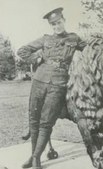Captain, U. S. A. - Late Twenty-first Canadian Battalion
Publishers - The Bobbs-Merrill Company (Copyright 1918)
Observations: by Badger
Note: Original PDF file of complete book located courtesy of MILSURPS.COM member Light Infantry
To The Memory Of William Emmanuel Bouchard
Lance-Corporal, Machine Gun Section
Twenty-first Canadian Infantry Battalion

(Click PIC to Enlarge
Killed in Action, at Courcellette - September 15th, 1916
In Flanders' fields the crosses stand--
Strange harvest for a fertile land!
Where once the wheat and barley grew,
With scarlet poppies running through.
This year the poppies bloom to greet
Not oats nor barley nor white wheat,
But only crosses, row by row,
Where stalwart reapers used to go.
Harvest in Flanders
--Louise Driscoll
Lance-Corporal, Machine Gun Section
Twenty-first Canadian Infantry Battalion
(Click PIC to Enlarge
Killed in Action, at Courcellette - September 15th, 1916
In Flanders' fields the crosses stand--
Strange harvest for a fertile land!
Where once the wheat and barley grew,
With scarlet poppies running through.
This year the poppies bloom to greet
Not oats nor barley nor white wheat,
But only crosses, row by row,
Where stalwart reapers used to go.
Harvest in Flanders
--Louise Driscoll
INTRODUCTION by HERBERT W. McBRIDE
When the final history of this war is written, it is doubtful if any other name will so appeal to the Canadian as Ypres and the Ypres Salient; every foot of which is hallowed ground to French, Belgians, British and Colonials alike; not a yard of which has not been consecrated to the cause of human liberty and baptized in the blood of democracy.
Here the tattered remnants of that glorious "contemptible little army," in October, 1914, checked the first great onrush of the vandal hordes and saved the channel ports, the loss of which would have been far more serious than the capture of Paris and might, conceivably, have proved the decisive factor in bringing about a Prussian victory in the war.
Here the first Canadian troops to fight on the soil of Europe, the Princess Pat's, received their trial by fire and came through it with untarnished name, and here, also, the First Canadian Contingent withstood the terrible ordeal of poison gas in April, 1915, and, outnumbered four to one, with flank exposed and without any artillery support worthy of mention, hurled back, time after time, the flower of the Prussian army, and, in the words of the Commanding General of all the British troops: "saved the situation."
Here, too, as was fitting, we received our baptism of fire (Second Canadian Division), as did also the third when it came over.
For more than a year this salient was the home of the Canadian soldier and Langemarck, St. Julien, Hill 60, St. Eloi, Hooge, and a host of other names in this sector, have been emblazoned, in letters of fire, on his escutcheon.
Baffled in his attempts to capture the city of Ypres, the Hun began systematically to destroy it, turning his heaviest guns on the two most prominent structures: The Halles (Cloth Hall), and St. Martin's Cathedral, two of the grandest architectural monuments in Europe. Now there was no military significance in this; it was simply an exhibition of unbridled rage and savagery. With Rheims Cathedral, and hundreds of lesser churches and châteaux, these ruins will be perpetual monuments to the wanton ruthlessness of German kultur.
When we first went there the towers of both these structures were still standing and formed landmarks that could be seen for miles. Gradually, under the continued bombardment, they melted away until, when I last passed through the martyred city, nothing but small bits of shattered wall could be seen, rising but a few feet above the surrounding piles of broken stones.
Glorious Ypres! Probably never again will you become the city of more than two hundred thousand, whose "Red-coated Burghers" won the day at Courtrai, against the trained army of the Count d'Artois; possibly never again achieve the commercial prominence enjoyed but four short years since; but your name will be forever remembered in the hearts of men from all the far ends of the earth where liberty and justice prevail.
Collector's Comments and Feedback:
1.To read another excellent book by Herbert W. McBride, please refer to the Articles & Books Section of the Knowledge Library and download A Rifleman Went To War (by Herbert W. McBride) (Click Here) ...... (Feedback by "Badger")
2. As per the Copyright Act, copyright in a work exists for the life of the author/creator, the remainder of the calendar year in which he is deceased, plus fifty years after the end of that calendar year.
For government copyrighted works, there is a slight difference. Section 12 of the Copyright Act stipulates:
“12. Without prejudice to any rights or privileges of the Crown, where any work is, or has been, prepared or published by or under the direction or control of Her Majesty or any government department, the copyright in the work shall, subject to any agreement with the author, belong to Her Majesty and in that case shall continue for the remainder of the calendar year of the first publication of the work and for a period of fifty years following the end of that calendar year. [S.C. 1993, c. 44, s. 60(1)]” ...... (Feedback by "Badger")









 Countries
Countries Categories
Categories